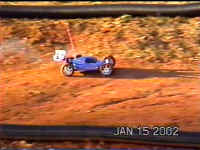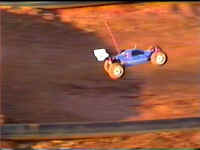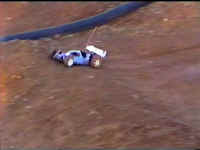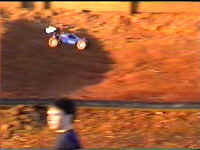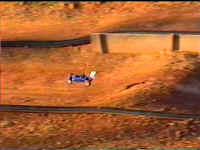Back
to Page One
Step twelve is also in the XR
manual and deals with the steering rod building and
installation. Step thirteen is in the XR manual and
has the building and installation of the front and rear tension
rods. These help to stiffen up the chassis. Step
fourteen is in the XR manual and deals with the installation
of the stone guards onto the main chassis. Steps fifteen,
sixteen, seventeen, eighteen, nineteen, twenty, and twenty-one deal
with the clutch installation onto the engine; engine installation
to the mounts and in turn the mounts to the chassis; exhaust
system (including the fuel tank and fuel lines); radio
gear, receiver battery and servo installation (including the
linkage for these and adjustment information).
**NOTE: The engine, exhaust system, radio gear, servos,
and receiver battery are NOT included and must be supplied
by you**
Interestingly there
is no step twenty-two in either the XR or the RR
manual. They both go from step twenty-one to step
twenty-three, which by the way is in the XR manual. Step
twenty-three deals with the linkage rod between the steering servo
and the servo saver on the car. The length will vary
depending on the servo and servo horn you use, therefore no length
is given for this rod.
Step twenty-four, which is in the RR book, is the building and installation of the air filter. Steps twenty-five, twenty-six and twenty-seven are the building and installation of the shocks and are found in the XR manual. Step twenty-eight, in the XR book, is the building of the wing mount, then installing the wing mount on the rear shock tower and finally installation of the wing to the mount itself. The last two parts of step twenty-eight are in the RR manual. Steps twenty-nine through thirty-two are all in the RR manual and deal with the tire/wheel building and installation; the body painting, trimming and installation.
Last, but definitely not least are the starting instructions if you are using the Mugen Pro Starter II starter box. Since the building pictures are getting a little boring, not to mention monotonous, I will skip these last few building photos and get into my impression of the buggy. Let me first of all, if I have not expressed this yet let me do so now, the quality of this kit is superlative. The parts are smooth, well built and fit together effortlessly (without modification). I did, however, change a few things in the building process on my XR. I used shock reservoirs and braces that are not included in the Mugen kit. I did not do this because the shock reservoirs and braces included in the kit are not up to the task. I chose to use the different items out of personal preference, as those I chose offer me the ability to tailor the buggy to my preference. The suspension design is rugged and offers practically total adjustability. The pillow ball front is strong, has exceptionally smooth steering and offers an uncompromising turning radius, as well as virtually zero bump steer. The method I use to measure bump steer is to position the front wheels straight and then push them one at a time from full droop to full compression. I observe whether the tire turns either in or out. Using this method with the Mugen, the tires scarcely moved, and what little movement was there wasn't enough that I felt would affect control of the buggy while racing. If you check around, there are quite a few on and off road vehicles currently using this setup. I'm not certain if Mugen coined it, nonetheless it undeniably works and works impeccably. The front suspension is fully adjustable for toe, caster, camber, ride height and suspension droop/compression. The steering Ackerman angle is two position adjustable. You can also mount a sway bar which is included in the kit. The pillow balls also allow you to widen the stance of the buggy if you so desire. The shocks have a multitude of holes which allow for diversity in their adjustment. The rear suspension allows for various adjusting as well. You can change toe, caster, camber and ride height. You can set the maximum allowable droop and compression as well as install a sway bar. The rear suspension design is, in general, like that of other manufacturers, except for a unique distinction found on the ends of the lower rear arms where they connect to the hub carriers. They are adjustable ends that allow you to change toe and to widen the stance. Most other manufacturers use a block or blocks where the arm attaches to the chassis to set toe. Not to mention that these are preset and non-adjustable unless you change blocks. The Mugen, on the other hand, allows for modification by turning the adjustment screws in and out. The rear shocks also have a vast abundance of holes allowing various adjustments to be made.
One more adjustment to the Mugen MBX4XR kit is the rear wing. It is angle adjustable, which allows the racer to change the "down force" applied to the buggy during racing. This is a common adjustment overlooked by most racers and an adjustment that can make a very substantial difference on how the buggy handles. The plastic parts in the kit are well formed and the plastic itself is very durable and holds its shape though quite a lot of abuse. The one part on the car that is made of plastic that really needs to be replaced with aluminum is the front upper suspension mount, this part wears rapidly due to the hinge pins rotation and needs replacement often if the buggy is raced hard. As of the writing of this article, Mugen does not make this part in aluminum, but it is available through aftermarket companies. The chassis is made of 70-75 aluminum that is 3.5mm thick and has the side edges rolled upward to aid in the chassis stiffness. It will take quite a lot of abuse and hold its shape. The front and rear included braces also aid in reducing chassis flex. All the other aluminum parts are anodized purple and are first quality in fit and finish, the center decomposable differential mount makes taking the differential out for maintenance a much easier task, not to mention it just flat out looks good. The shocks are gray anodized and come with silver springs, and a set of shock preload adjustment collars. These snap onto the shock bodies to change ride height and spring tension.
After building the buggy, I went to Mugens web site
and downloaded a set up sheet from one of their racers, I modified
it a little for my tastes and the car has handled well using this
setting. It has just a little push and jumps very well.
It has very good control over small ruts and bumps, turns very fast
and is nimble at high speeds but not twitchy. I have
been very happy with its track manners and my lap times improve
every time I take it out to practice. Once I learn more about
setup I am positive I can improve them even more. If a top of
the line racing buggy is in your future, take a hard look at what
Mugen has to offer in the XR kit. I don't think you will be
disappointed. Below is a list of items required to run the
car. Also a list of the products I used in this review.
Under that are some track shots (I apologize about their quality),
misc. pictures and a couple of small video clips of the buggy in
action. One is taking a twenty-eight foot double and the
second is a testimony to the Mugens toughness, I think you'll
understand when you watch it! LOL
ITEMS NEEDED TO RUN
|
PRODUCTS USED
|
Action Shots and Misc. Pictures
Any questions or comments related to this review please feel free to email me.
Glenn R. Viveiros
 20914 Bake Parkway #106
20914 Bake Parkway #106Lake Forest, CA 92630, U.S.A.
Phone: 949-707-5607
FAX: 949-707-5614
E-mail: support@mugenracing.com

